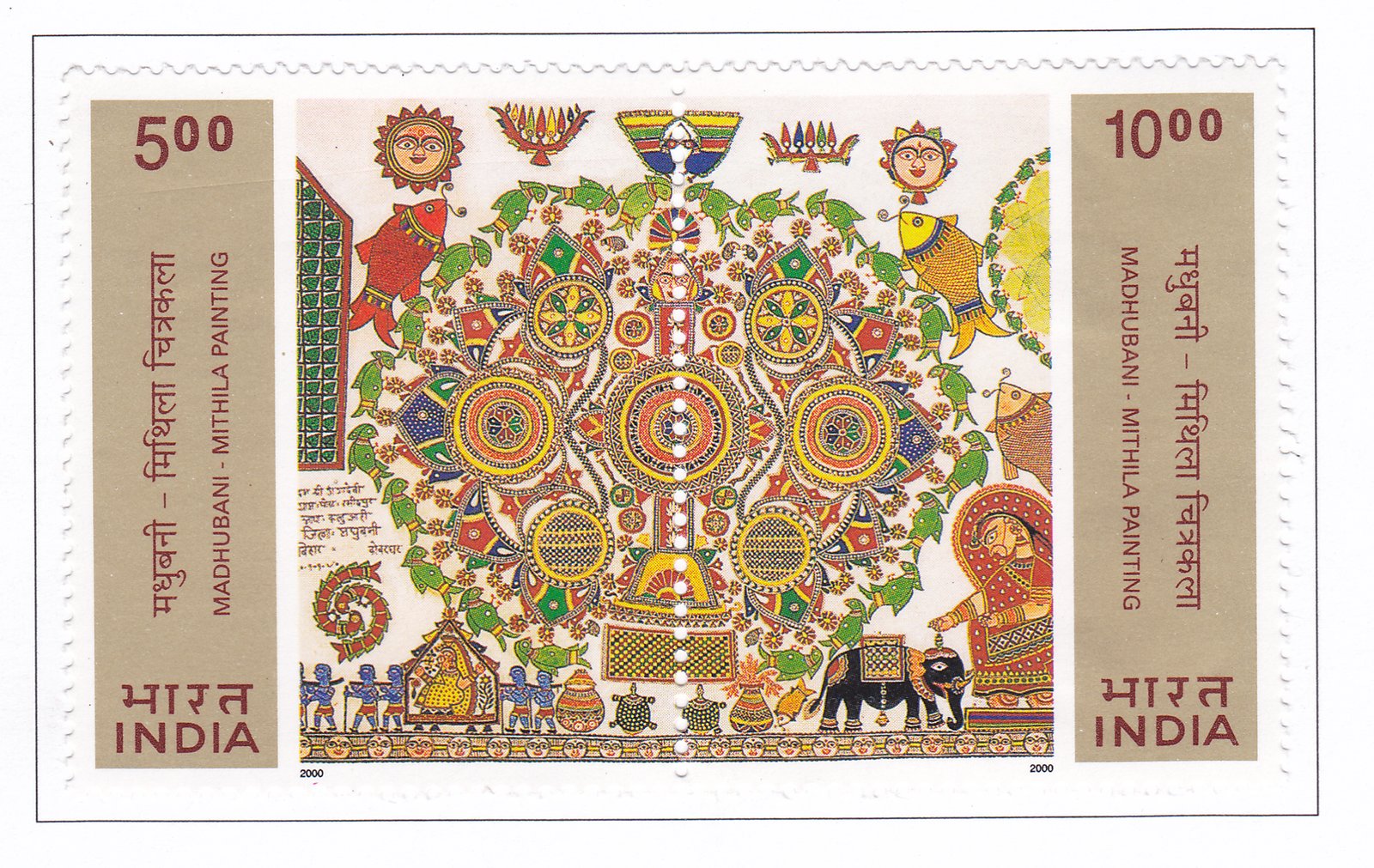“Kohbar Ghar” Mural (Ganga Devi) Se-tenant Pair

Technical Data
| Stamp Set | Madhubani Mithila Paintings |
|---|---|
| Date of Issue | October 15, 2000 |
| Denomination | Rs. 15 |
| Quantity | 3,000,000 |
| Perforation | comb 13½ |
| Printer | Calcutta Security Printers Ltd |
| Watermark | No Watermark |
| Colors | Multicolor |
| Catalog Codes |
Michel IN 1789-1790 Stamp Number IN 1853 Yvert et Tellier IN 1555-1556 Stanley Gibbons IN 1958a |
| Themes | Animals (Fauna) | Art | Elephants | Mammals | Paintings |
Table of Contents
Commemorative Stamp Set: Madhubani/Mithila Paintings
Design Elements:
The commemorative stamp set features paintings from the renowned Madhubani/Mithila art tradition, created by women artists from Bihar. The four stamps highlight key aspects of the region’s cultural and artistic heritage:
- “Flower Girls” (Nirmala Devi): A depiction of rural life through stylized floral and human motifs, showcasing the charm of simplicity in daily activities.
- “Bali and Sugriva” (Sanjula Devi): A narrative from Indian mythology, represented with bold colors and minimalistic patterns.
- “Krishna with Gopies” (Anmana Devi): A divine scene from Hindu mythology, emphasizing Krishna’s enchanting relationship with the Gopies through intricate detailing and harmonious composition.
- Kohbar-Ghar Mural (Ganga Devi): A traditional wedding chamber painting, centered around themes of fertility, life, and growth, symbolized through the lotus plant motif and detailed embellishments of flora and fauna.
Cultural and Historical Significance:
- Madhubani Tradition: This art form originated in Mithila, a region that has upheld its cultural identity through centuries-old practices of creating ritualistic art. Women played a central role in developing these vibrant styles, originally using rice paste on floors and walls to celebrate significant life events, especially weddings.
- Folk and Mythological Themes: The featured paintings encapsulate Mithila’s artistic legacy, drawing heavily on mythology, daily life, and ritualistic symbolism. The introduction of paper as a medium in the 1960s led to the evolution of this folk art, allowing greater narrative complexity and individual artistic expression.
- Natural Pigments: The traditional use of natural colors—derived from cow dung, vermilion, turmeric, and indigo—imbues the paintings with earthy tones, adding depth and cultural resonance to the artworks.
Usage:
- Cultural Representation: This stamp set celebrates the cultural diversity and artistic excellence of Mithila, representing a rural art form that has reached global recognition.
- Commemorative: It pays homage to the women artists of Madhubani, recognizing their creativity and their contributions to India’s rich folk art tradition.
- Educational: These stamps serve as a window into India’s vibrant traditions, promoting awareness and appreciation of the country’s unique artistic heritage.
Importance of the Commemorative Stamp Set:
- Cultural Preservation: By featuring Madhubani paintings on stamps, this set helps preserve and promote traditional folk art for both domestic and international audiences.
- Artistic Recognition: The stamps acknowledge the contribution of women artists who have kept this ritualistic art alive and adapted it to new mediums, ensuring its relevance in contemporary times.
- Philatelic Value: Collectors and art enthusiasts will find immense value in this set, as it reflects both the traditional and contemporary interpretations of folk art.
Example of the Stamp Design:
- The design for the “Krishna with Gopies” stamp features a central figure of Krishna, surrounded by milkmaids in a lively composition, blending mythical storytelling with Madhubani’s distinctive folk style. The intricate patterns and natural color palette make it a visually striking piece.
The Commemorative Stamp Set Might Include:
- Ritual Paintings: Examples of Aripan designs, used in household decorations for auspicious occasions.
- Narratives from Mythology: Depictions of stories like the Ramayana and Krishna Lila, continuing the tradition of integrating folklore and art.
Significance:
This commemorative stamp set emphasizes the artistic achievements of rural women from the Mithila region, celebrating their cultural contributions to Indian folk art. It reflects the timeless beauty of Madhubani paintings, which continue to enchant people with their intricate designs and deep-rooted connection to everyday life and mythology. Through these stamps, India promotes its artistic heritage and highlights the creative spirit of women artists from Mithila.
